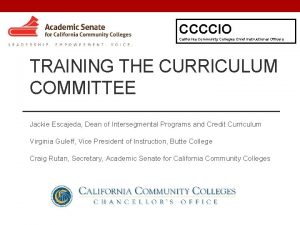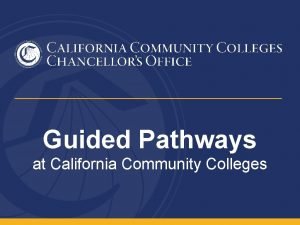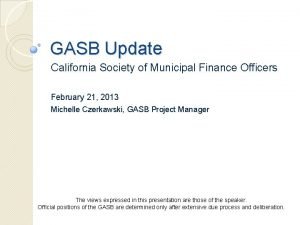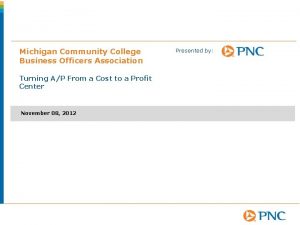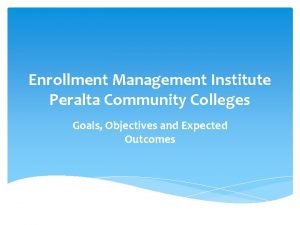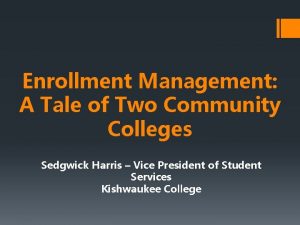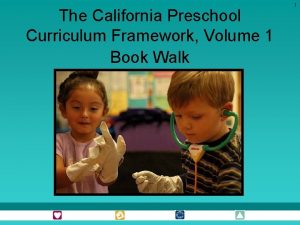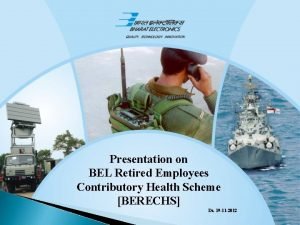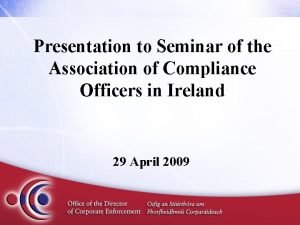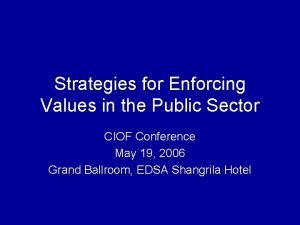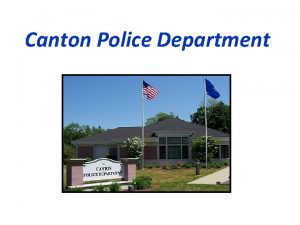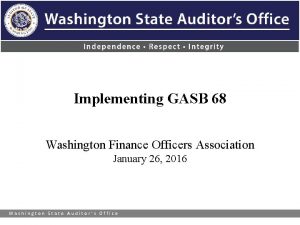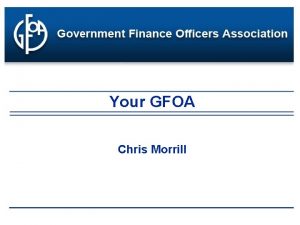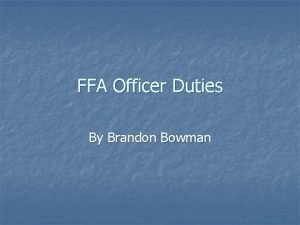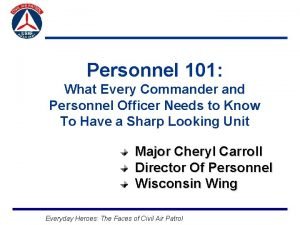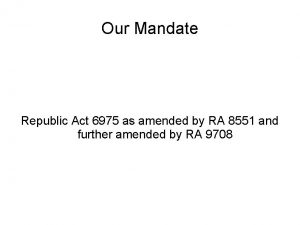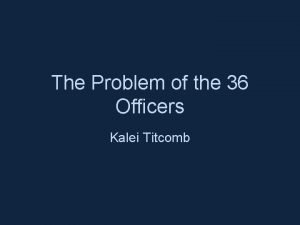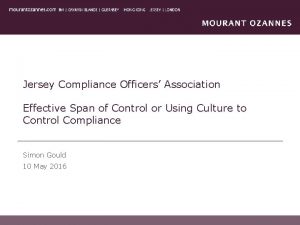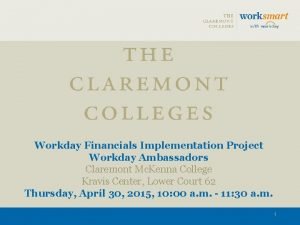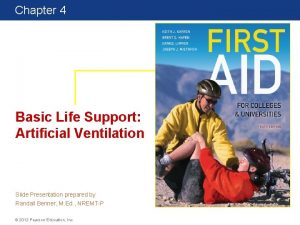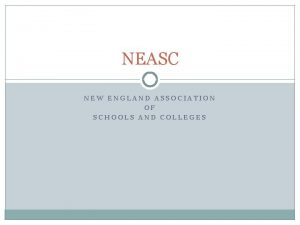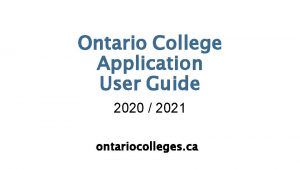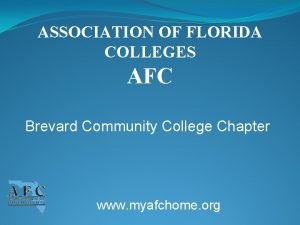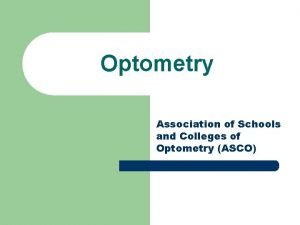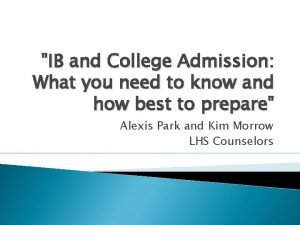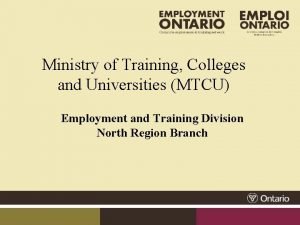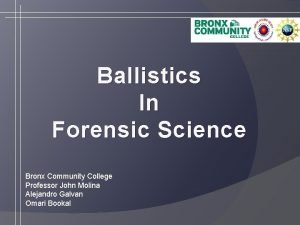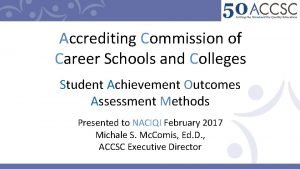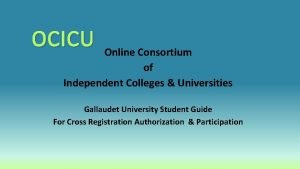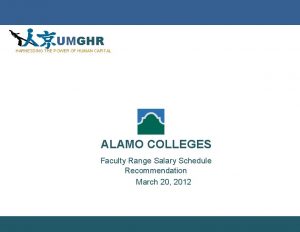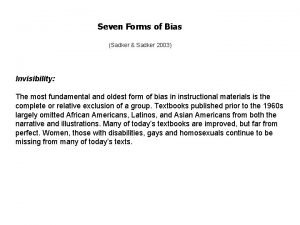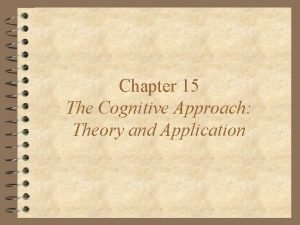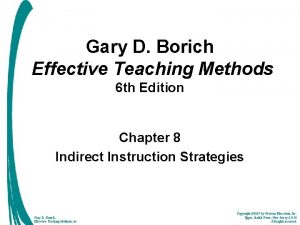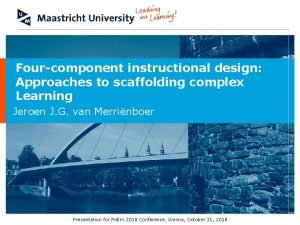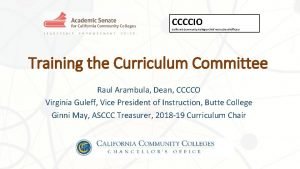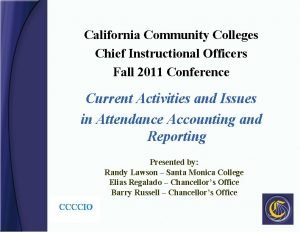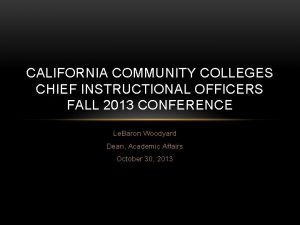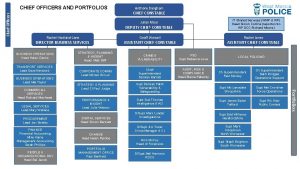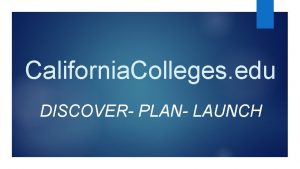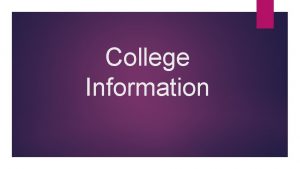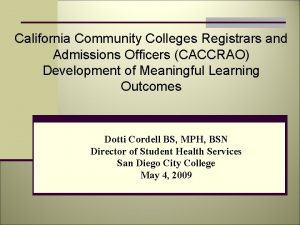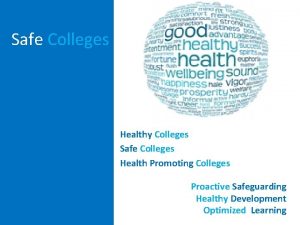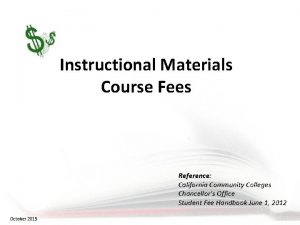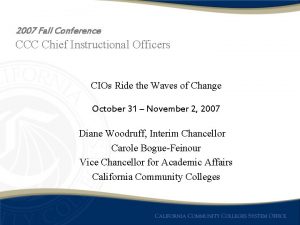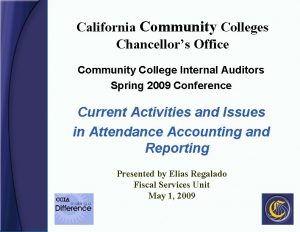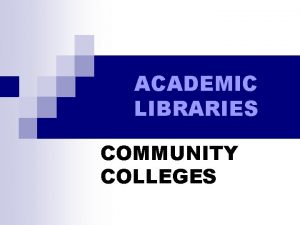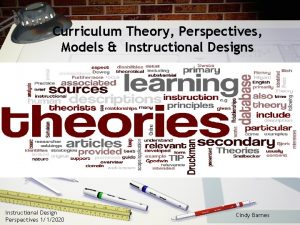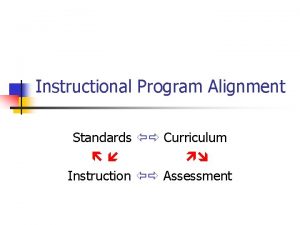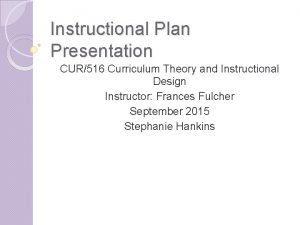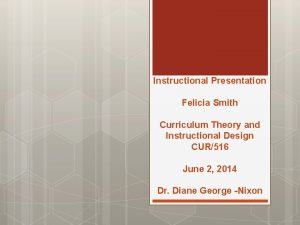CCCCIO California Community Colleges Chief Instructional Officers Curriculum



















































































- Slides: 83

CCCCIO California Community Colleges Chief Instructional Officers Curriculum Workshop Jackie Escajeda, CCCCO Virginia Guleff, CCCCIO Virginia May, ASCCC The Dana at Mission Bay, San Diego October 24, 2018

Overview • Scenarios to consider… • Roles and Responsibilities • Curriculum Streamlining • Training the Curriculum Committee • Credit Hour Calculation • Certificates, Degrees, and Funding Formula • More… • Scenarios for discussion… • Questions?

Scenarios to Consider…

Scenario 1 At Birch Tree College, faculty are embracing AB 705 and have written corequisite courses for each of the entry transfer level English and mathematics courses. For those students that are required to take the corequisite course, passing the corequisite course is contingent upon passing the parent course and vice versa. The corequisite courses range from 2 to 3 units and the parent courses from 3 to 5 units. 1. What are the pros and cons with this model? 2. What else would you like to know about this model? 3. What options would you ask faculty to consider?

Scenario 2 At Cedar Tree College, more students transfer to UC or private non-profit colleges than to CSU colleges. The Board of Trustees has asked the administration to find ways: a. To encourage students to pursue ADT degrees over local degrees; b. To increase the number of CTE courses that have CSU GE-Breadth approval; c. To ensure that all Certificates of Achievement are at least 16 units; and d. Implement auto-awarding of certificates and degrees. 1. What are the pros and cons of these requests? 2. How do you address these requests?

Roles and Responsibilities— Academic Senate and CIO

Roles and Responsibilities • The curriculum committee—Title 5 § 55002: (1) Curriculum Committee. The college and/or district curriculum committee recommending the course shall be established by the mutual agreement of the college and/or district administration and the academic senate. The committee shall be either a committee of the academic senate or a committee that includes faculty and is otherwise comprised in a way that is mutually agreeable to the college and/or district administration and the academic senate.

Roles and Responsibilities Title 5 § 53200 aka The “ 10+1” 1. Curriculum, including establishing prerequisites 2. Degree & Certificate Requirements 7. Faculty roles and involvement in accreditation process 3. Grading Policies 8. Policies for faculty professional development activities 4. Educational Program Development 9. Processes for program review 5. Standards & Policies regarding Student Preparation and Success 10. Processes for institutional planning and budget development 6. College governance structures, as related to faculty roles 11. Other academic and professional matters as mutually agreed upon

Roles and Responsibilities Title 5 § 53200 (d). . . the district governing board shall develop policies on academic and professional matters through either or both of: 1. Rely primarily upon the advice and judgment of the Academic Senate 2. Reach mutual agreement with the Academic Senate by written resolution, regulation, or policy

Roles and Responsibilities • The Board has the final say. • The Board is never prohibited from acting. • “Exceptional circumstances” and "compelling reasons" vs. "compelling legal, fiscal, or organizational reasons. "

Roles and Responsibilities Title 5 § 53203 (a) Governing Board shall adopt policies for appropriate delegation of authority and responsibility to its academic senate and requires collegial consultation. (b) Policies in (a) shall be adopted through collegial consultation with the academic senate. (c) Guarantees the academic senate the right to meet with or appear before the board while in the process of consulting collegially.

Roles and Responsibilities Title 5 § 53203 (d) The governing board of a district shall adopt procedures for responding to recommendations of the academic senate that incorporate the following:

Roles and Responsibilities Title 5 § 53203 (1) When rely primarily: the recommendations of the senate will normally be accepted, and only in exceptional circumstances and for compelling reasons will the recommendations not be accepted. If a recommendation is not accepted, the governing board or its designee, upon request of the academic senate, shall promptly communicate its reasons in writing to the academic senate.

Roles and Responsibilities Title 5 § 53203 (2) When mutually agree (and an agreement has not been reached): Existing policy shall remain in effect except in cases of legal liability or fiscal hardship. Board may act, after a good faith effort to reach agreement, only for compelling legal, fiscal, or organizational reasons.

Roles and Responsibilities Title 5 § 53203 (e) Academic Senate may assume responsibilities and perform functions as may be delegated by the Governing Board. (f) Appointment of faculty members to college committees shall be made by the Academic Senate in consultation* with CEO or designee; collective bargaining agent may seek to appoint faculty (per local policies and collective bargaining agreements). *Note that “consultation” with the president is not the same as “consult collegially”.

Roles and Responsibilities Title 5 § 53206 establishes the Academic Senate for California Community Colleges: • “so that the community college faculty of California may have a formal and effective procedure for participating in the formation of state policies on academic and professional matters” and • “The Board of Governors recognizes the Academic Senate for California Community Colleges as the representative…before the Board of Governors and Chancellor’s Office”

Roles and Responsibilities Composition of the Curriculum Committee • The Curriculum Chair/Co-chairs • Discipline Faculty • Administrators • Classified Staff • Counseling Faculty • Articulation Officers • Student Representatives

Roles and Responsibilities Faculty Curriculum Chair • Leadership Role • Assist in the development of new • Liaison to Academic Senate, CIO, courses Program Review, Accreditation, • Facilitate technical review Board of Trustees, etc. • Build the agenda • Arbitrator • Prepare for the meeting • Mediator • Chair the meeting • Negotiator • Follow up work • Guide Curriculum Review process • Meet with discipline faculty

Roles and Responsibilities • • • The Curriculum Committee is subject to the requirements of the Brown Act. All meetings must be open to anyone who wishes to attend. The public must be allowed to make comments. All items being voted on must be included on an agenda that is posted at least 72 hours prior to the meeting. Only a single reading is required but many colleges have two readings. Action can only be taken on items listed for action. Items listed for discussion or from public comments can only be acted on after a motion has passed to suspend the rules.








Curriculum Streamlining


Senate President/Curriculum Chair/CEO/CIO Certification

Annual Credit Course and Program Certification Memo • 2 nd Certification was due Fall 2017 • 3 rd Certification was due October 16, 2018 The Curriculum Chair, CIO, Academic Senate President, and CEO certify and submit the following to the Chancellor’s Office for Chaptering: • All credit courses • Modified credit programs with the exception of ADTs • New credit programs with a goal of local program with the exception of new CTE credit programs and Apprenticeship

Annual Credit Course and Program Certification What is the difference between Chancellor’s Office approval and Chancellor’s Office Chaptering? All courses and programs that receive Chancellor’s Office approval whether through Chancellor’s Office review or the Annual Course and Program Certification are Chaptered at the Chancellor’s Office.

Requirements of Certification • Colleges are certifying that all approved curriculum will align with all requirements outlines in Education Code, Title 5, and the 6 th edition of the Program and Course Approval Handbook • College must have a board policy related to the credit hour. Policy must be submitted to the CO with the certification memo. • College must have a cooperative work experience plan that has been approved by the local governing board (plan does not need to be submitted to the CO)

Training the Curriculum Committee and the Board…

Types of Courses and Programs Credit Noncredit Courses • • • Degree-applicable Non degree-applicable Noncredit: no credit awarded for courses in 10 categories but approved by CO and receives apportionment Programs • • • Associate Degrees (AA, AS) Associate Degrees for Transfer (AA-T, AS-T) Certificates of Achievement 12 -18 8 to <16 units 18 16 or more units Locally Approved Certificates <18 16 units, CO approval optional if 8 or more units but not required Certificate of Completion (CDCP) Certificate of Competency (CDCP) Adult High School Diploma Noncredit Apprenticeship Program Locally Approved Certificates (not CO approved)

Requirements for Credit Courses • • • Course Number and Title Catalog Description Prerequisites, Corequisites, Advisories Units Total Contact Hours Total Number of Hours in Each Instructional Category Outside of Class Hours Course Content Objectives (Title 5)/Outcomes (ACCJC) Instructional Methods • • Grading criteria (letter grade, P/NP) Methods of Assessment Reading, Writing, and Outside of Class Assignments Repeatability Options Open Entry/Open Exit Justification of Need CCCCO Data Elements (e. g. TOP and SAM Codes, CB codes) Discipline Assignment(s)

Possible Items for COR Item Why you might want it Student Learning Outcomes ACCJC Standard II. A. 3 Required and Recommended Textbooks Aids in C-ID and 4 -yr articulation; helps new instructors Transfer/GE Information/C-ID It can be helpful to have this info on the COR Supplemental Instruction Could SI be part of your course? Distance Education Include modalities (e. g. online, hybrid) and possibly DE Addendum Enrollment limits Instructional quality, external accreditation requirements

Substantial & Nonsubstantial Credit Programs • Substantial and nonsubstantial changes for all credit programs will be merged and renamed modified programs. • Required attachments for modified Certificates of Achievement (COAs) and local degrees: A. Required CORs B. Revised Narrative to include: 1. Program Goals and Objectives 2. Catalog Description 3. Program Requirements

Substantial & Nonsubstantial Credit Programs • Required attachments for modified Associate Degrees for Transfer (ADTs): • Required CORs A. Revised Transfer Model Curriculum (TMC) B. Articulation Agreement by Major (AAM), CSU Baccalaureate Course List by Department (BCT), and CS GE Certification Course List by Area (GETCC) as required C. Revised Narrative to include: 1. Program Goals and Objectives 2. Catalog Description

Requirements for Associate Degrees • Minimum of 60 units • At least 18 units in a major or area of emphasis • Can use local GE pattern • Chancellor’s Office Approval if goal is CTE. Local Approval if goal is Local • All modified degrees are locally approved

Associate Degrees for Transfer (ADTs) • Minimum of 60 units; no more than 60 units may be required • At least 18 units in a major • General education limited to a CSU GE-Breadth or IGETC pattern • New and modified ADT’s require Chancellor’s Office approval 40

Certificates of Achievement • 16 or more related units must be Chancellor’s Office approved, noted on transcript. • 8– 15. 5 units may be Chancellor’s Office approved, but it is not required (although it is recommended)* • All new certificates with a goal of Transfer or CTE must be approved by the Chancellor’s Office. All revisions and new certificates with a goal of Local are locally approved. *Certificates noted on students’ transcript must be approved by the Chancellor’s Office. 41

Training the Board… • Trustees might feel like they should take a more active role in curriculum approval now that the Chancellor’s Office has shifted their approval to the college. • A board’s primary responsibility is to establish policy and Education Code § 70902 (b)(7) requires board’s to create policy to “ensure the right of academic senates to assume primary responsibility for making recommendations in the areas of curriculum and academic standards. ” • Local curriculum committees and administrators have always been responsible for the requirements of the streamlining certification, local boards should continue to trust them to meet those requirements.

Training the Board… • Curriculum should come to the board at least once a month. • All disciplines should be able to bring curriculum to the board at any meeting. • Boards should list curriculum as a consent item and only pull if there are questions or concerns. • Boards should send curriculum questions to the college before the meeting.

Helping the Board… • Ensure that all curriculum proposals have been reviewed by faculty and administrators to ensure compliance. • Major curriculum changes should be discussed with students before it is sent to the board. • The CIO and Curriculum Chair should attend board meetings to answer any questions on curriculum submissions.

Credit Hour Calculation & Cooperative Work Experience

Title 5 Requirements for Credit Hour California Code of Regulations, title 5 § 55002. 5 (f) The governing board of each community college district shall establish policy, consistent with the provisions of this section, defining the standards for credit hour calculations. District policy shall specify the credit hour calculation method for all academic activities, expected ratios of in-class to outside-of class hours for each type of academic activity, standards for incremental award of credit, standard term length, calculation methods for short term and extended term courses, and provisions for monitoring compliance with state and federal regulations related to credit hour calculations. Huh? ? ?

New: Local Governing Board Policy Now REQUIRED by new title 5 regulations - § 55002. 5(f) District policy shall specify: • the credit hour calculation method for all academic activities (lecture, activity, lab, clinical, discussion, studio, work experience, etc. ) • expected ratios of in-class to outside-of class hours for each type of academic activity • standards for incremental award of credit • standard term length (number used to determine divisor in calculation) • calculation methods for short term and extended term courses • provisions for monitoring compliance with state and federal regulations related to credit hour calculations Local policy is an academic and professional matter and should fall under your 10+1 process.

Standards for Credit Hour California Code of Regulations, title 5 § 55002. 5(a) “(a) One credit hour of community college work (one unit of credit) shall require a minimum of 48 semester hours of total student work or 33 quarter hours of total student work which may include inside and/or outside-of-class hours. ”

Sample Credit Hour Calculation To Calculate Units : *54 is used for this example based on the recommendation from the Chancellor’s Office that local districts use an 18 week semester as the basis for calculating hour to unit ratios on Course Outlines of Record. Likewise, . .

Cooperative Work Experience • APPROVED PLAN REQUIRED - § 55250 • REQUIREMENTS OF THE PLAN - § 55251 • WORK EXPERIENCE CREDIT - § 55265. 5 • Approved at the July Board of Governor’s meeting and the revisions to regulations for CWE plans and courses will: • Support the streamlining of curriculum by transferring authority from the Chancellor’s Office to local districts to approve CWE plans and courses. • Allow colleges to incremental units.

CWE - REQUIREMENTS OF THE PLAN Title 5 § 55250 Any program of Cooperative Work Experience Education conducted by the governing board of a community college district pursuant to this article and claimed for apportionment pursuant to sections 58051 and 58009. 5 shall conform to a plan adopted by the district. The plan adopted by the district shall set forth a systematic design of Cooperative Work Experience Education whereby students, while enrolled in college, will gain realistic learning experiences through work. This plan shall be submitted to and approved by the Chancellorlocal governing board.

CWE – Title 5 § 55251. REQUIREMENTS OF THE PLAN (a) The district plan shall contain the following provisions: (1) A statement that the district has officially adopted the plan, subject to approval by the State Chancellorlocal governing board. (2) A specific description of the respective responsibilities of college, student, employer, and other cooperating agencies in the operation of the program. (3) A specific description for each type of Cooperative Work Experience Education program. (4) A description of how the district will: (A) Provide guidance services for students during enrollment in Cooperative Work Experience Education. (B) Assign a sufficient number of qualified, academic personnel as stipulated in the district plan to direct the program and to assure district services required in section 55255. (C) Assure that students' on-the-job learning experiences are documented with written measurable learning objectives. (D) With the assistance of employers, evaluate students’ on-the-job learning experiences. (E) Describe basis for awarding grade and credit. (F) Provide adequate clerical and instructional services. (b) Prior to implementation, any changes or revisions to the district plan shall be submitted for approval to the Chancellorlocal governing board.

CWE - § 55256. 5. Work Experience Credit (a) One student contact hour is counted for each unit of work experience credit in which a student is enrolled during any census period. In no case shall duplicate student contact hours be counted for any classroom instruction and Cooperative Work Experience Education. The maximum contact hours counted for a student shall not exceed the maximum number of Cooperative Work Experience Education units for which the student may be granted credit as described in section 55253. (b) The learning experience and the identified on-the-job learning objectives shall be sufficient to support the units to be awarded. (c) The following formula will be used to determine the number of units to be awarded: (1) Each 75 hours of paid work equals one semester credit or 50 hours equals one quarter credit. (2) Each 60 hours of non-paid work equals one semester credit or 40 hours equals one quarter credit. (3) Units may be awarded in 0. 5 unit increments.

Certificates, Degrees, and the Funding Formula

Attention… • Changes to Title 5 § 55070: Certificate of Achievement unit requirements modified by the Board of Governors in July 2018 • All programs should be based on: • • • Appropriate to Mission Need Curriculum Standards Adequate Resources Compliance

Title 5 § 55070 (a) Any sequence of courses consisting of 16 or more semester units or 24 or more quarter units of degree-applicable credit coursework shall constitute an educational program subject to approval by the Chancellor pursuant to section 55130. The college-awarded document confirming that a student has completed such a program shall be known as a certificate of achievement and may not be given any other designation. The award of a certificate of achievement is intended to represent more than an accumulation of units. Listing of the certificate of achievement on a student transcript symbolizes successful completion of patterns of learning experiences designed to develop certain capabilities that may be oriented to career or general education; provided however, that no sequence or grouping of courses may be approved as a certificate of achievement pursuant to this section if it consists solely of basic skills and/or ESL courses. For purposes of this subdivision, the term “general education” includes coursework taken to satisfy transfer patterns established by the University of California, the California State University, or accredited public postsecondary institutions in adjacent states which award the baccalaureate degree.

Certificates of achievement (16+ units) 1. CSU GE Breadth or IGETC Certificate 2. Career and Technical Education (CTE) Certificate • Labor Market Information (LMI) and analysis • Advisory Committee Recommendation • Regional Consortia Approval [Endorsement*] approval meeting minutes 3. Local (non-CTE) Certificate NOTE: Certificates of Achievement that consist solely of basic skills and/or ESL courses are not permitted. NOTE: The PCAH does NOT reflect the changes to Title 5 regarding unit thresholds!

Certificates of achievement (16+ units) Local (non-CTE) Certificate – may include… • Programmatic articulation agreements • ASSIST documentation verifying that a majority (51% or greater) of required courses in the program are articulated for the major (AAM) at the single baccalaureate institutions to which the program’s students are likely to transfer • Table of major requirements from the most recent catalogs, with catalog dates and page numbers cited, for targeted transfer institutions showing crosswalk with CCC program requirements • Summary of lower division major preparation published or endorsed by relevant professional bodies or programmatic accreditors, with citations included • Formal letters from the intended receiving institution that verify alignment of proposed program with their program curriculum

Certificates of Achievement (CTE) Labor Market Information (LMI) and Analysis • Ed Code 78015 requires this for all new CTE programs, where available Must show: • Jobs are available for program completers within the local service area of the individual college and/or that job enhancement or promotion justifies the proposed curriculum • Regional, statewide, or national labor market evidence may be included as supplementary support, but evidence of need in the specific college service area or region is also necessary.

Certificates of Achievement (CTE) Labor Market Information (LMI) and Analysis • Must include projections from LMI for the most applicable Standard Occupational Classification (SOC) codes and geographical regions to be served by the program. • If these projections do not suggest adequate job openings in the college service area to provide employment for all program completers, then the proposal must explain what other factors may justify the program and make the LMI figures misleading. • Program proposals will be evaluated in light of expected job openings within the next five years and the number of students that will complete the program per year

Certificates of Achievement (CTE) If LMI is not available, other data sources may include: • • • Recent employer surveys Industry studies Regional economic studies Letters from employers attesting to the service area need Minutes of industry advisory committee meetings (beyond required advisory committee meeting minutes) Job advertisements for positions in the individual college’s service area • Newspaper or magazine articles on industry or employment trends • Applicable studies or data from licensing agencies or professional associations • EDD’s LMI system (http: //www. labormarketinfo. edd. ca. gov)

Title 5 § 55070 (b) Shorter credit programs leading to a certificate may be established without review and approval by the Chancellor after approval by the college curriculum committee and the district governing board. Such a certificate may be given any name or designation deemed appropriate by the district governing board, except that such a certificate may not be referred to as a certificate of achievement, a certificate of completion, or a certificate of competency, unless approved by the Chancellor pursuant to subdivision (c). Such a certificate may not be listed on a student's transcript, unless approved by the Chancellor pursuant to subdivision (c).

Title 5 § 55070 (c) A district may submit any sequence of courses consisting of 8 or more semester units or 12 or more quarter units of degree-applicable credit coursework to the Chancellor and request that it be approved as a program leading to a certificate of achievement. The Chancellor may approve such a program if he or she determines that it satisfies the requirements of subdivision (a) despite requiring fewer than 16 semester or 24 quarter units of degree-applicable credit coursework.

Local Low Unit Certificates • Certificates of 8 or more semester units, but less than 16 units may be submitted to Chancellor’s Office for chaptering • Certificates of less than 8 units may not be submitted to Chancellor’s Office for chaptering • If one low-unit certificate (< 16 semester units) is a prerequisite to another low-unit certificate, then both certificates must go through the approval process and submitted to the Chancellor’s Office for Chaptering • Only certificates that have been chaptered by the Chancellor’s Office may be listed on a student’s transcript.

Local Low Unit Certificates Cannot be called… • Certificate of Achievement unless submitted to Chancellor’s Office for chaptering • Certificate of Completion (reserved for noncredit) • Certificate of Competency (reserved for noncredit) Examples of Low Unit Certificate Titles: • Certificate of Accomplishment • Skills Certificate • Other…

Eligible Noncredit Categories EC § 84757; CCR title 5 § 58160 Workforce Preparation Shortterm Vocational The underlined instructional categories are eligible for (CDCP) enhanced funding, in accordance with Education Code 84760. 5 and CCR title 5 section 55151 (i. e. , ESL, Elementary and Secondary Basic Skills, Short-term Vocational With High Employment Potential, and Workforce Preparation). Older Adults Home Economics ESL Noncredit Course Categories Parenting Immigrant Education Elementary and Secondary Basic Skills Health and Safety Substantial Disabilities

Title 5 § 55151 Career Development and College Preparation (CDCP) Programs • Certificate of Competency—a certificate in a recognized career field articulated with degree-applicable coursework, completion of an associate degree, or transfer to a baccalaureate institution (Basic Skills, ESL) • Certificate of Completion—a certificate leading to improved employability or job opportunities (Short-term Vocational, Workforce Preparation)

Noncredit CDCP Certificates Certificate of Completion • For career field with high employment potential • (§ 55151 (i)) – Short - term Vocational, Workforce Preparation OR Certificate of Competency • In a career field transitioning to credit, a degree, or baccalaureate institution • (§ 55151 (h)) – ESL, Basic Skills, VESL Completion counts for AEBG/AEP, SWP, and Scorecard metrics

Short-term Vocational Certificate of completion Proposals STV program proposals must provide evidence of high employment potential in one of two ways: Identify the area of instruction on the list of occupational titles with high employment potential (http: //www. labormarketinfo. ca. gov ) Attach another data source containing current labor market or job availability data with an explanation of how the data is verified No regional or advisory input required for STV certificate proposals

Program Submission Courses must first be approved before the college can submit a proposal for a new CDCP program CDCP funding for courses that are part of a CDCP program cannot be received until the program is approved Cannot divide a class that is 110 hours or less into two courses to create a certificate

Student Centered Funding Formula Completion Benchmark Local Associate Degree or Baccalaureate Degree (excludes ADT) Associate Degree for Transfer (ADT) Certificate of Achievement (16 or more units) Transfer level math and English within 1 st year Transfer to a four-year university Nine or more CTE units Obtains a regional living wage within one year of community college completion Points Awarded to College District 3 (per degree) 4 (per degree) 2 (per certificate) 2 (per student) 1. 5 (per student) 1 (per student)

Certificates summary Units Certificate Name 16 or more Must be submitted to CO for chaptering, counts in SCFF Certificate of Achievement 8 to less than 16 May be submitted to CO for chaptering, does not count in SCFF Certificate of Achievement if and only if submitted to CO for chaptering Less than 8 May not be submitted to CO for chaptering, does not count in SCFF Skills Certificate, Certificate of Accomplishment, or other locallynamed certificate 0 - Noncredit Must be submitted to CO for chaptering, does not count in SCFF Certificate of Completion or Certificate of Competency

More…

On the Horizon… • PCAH, 7 th Edition • Title 5 Changes • More…


Things to Keep in Mind • Colleges must submit all courses to the Chancellor’s Office using the Chancellor’s Office Curriculum Inventory (COCI). • Colleges are still required to have a course control numbers before offering courses and programs. • The Chancellor’s Office is still reviewing and approving all noncredit, new and modified ADTs, and new CTE programs. • The Chancellor's Office will conduct periodic reviews on all the courses that are receiving automated approvals.

Periodic Review by Chancellor’s Office • Colleges will have their curriculum reviewed at least once every three years (and could be as frequently as once a year). • Colleges that have been found to have curriculum that does not meet all requirements will be contacted by the CO. • Colleges may be encouraged to have an assistance visit by representatives from the CO, CIOs, and ASCCC • Colleges that refuse to follow the requirements for automated approval will have the approval disabled and all curriculum will need to be reviewed and approved by the Chancellor’s Office

Scenarios for Discussion…

Scenario 1 At Birch Tree College, faculty are embracing AB 705 and have written corequisite courses for each of the entry transfer level English and mathematics courses. For those students that are required to take the corequisite course, passing the corequisite course is contingent upon passing the parent course and vice versa. The corequisite courses range from 2 to 3 units and the parent courses from 3 to 5 units. 1. What are the pros and cons with this model? 2. What else would you like to know about this model? 3. What options would you ask faculty to consider?

Scenario 2 At Cedar Tree College, more students transfer to UC or private non-profit colleges than to CSU colleges. The Board of Trustees has asked the administration to find ways: a. To encourage students to pursue ADT degrees over local degrees; b. To increase the number of CTE courses that have CSU GE-Breadth approval; c. To ensure that all Certificates of Achievement are at least 16 units; and d. Implement auto-awarding of certificates and degrees. 1. What are the pros and cons of these requests? 2. How do you address these requests?

Questions? Thank You!

Acronyms ASCCC – Academic Senate for California Community Colleges PCAH – Program and Course Approval Handbook CCCCO or CO – California Community Colleges Chancellor’s Office or Chancellor’s Office AAM – Articulation Agreement for Major ADT – Associate Degree for Transfer COCO – Chancellor’s Office Curriculum Inventory SOC – Standard Occupational Classification TOP – Taxonomy of Program CSU GE – California State University General EDD – Employment Development Department Education CDCP – Career Development and College IGETC – Intersegmental General Education Preparation Transfer Curriculum COR – Course Outline of Record SCFF – Student Centered Funding Formula CTE – Career and Technical Education LMI – Labor Market Information CWE – Cooperative Work Experience

Resources • Program and Course Approval Handbook (PCAH) 6 th Edition: https: //asccc. org/sites/default/files/PCAH 6 th. Edition. July_FINAL. pdf • Title 5 § 55070 Credit Certificates: https: //govt. westlaw. com/calregs/Document/IAC 158694734046 EDAAA 1179 B B 5181 FA 9? view. Type=Full. Text&origination. Context=documenttoc&transition Type=Category. Page. Item&context. Data=(sc. Default) • Title 5 § 55155 Noncredit Certificates: https: //govt. westlaw. com/calregs/Document/IAC 158694734046 EDAAA 1179 B B 5181 FA 9? view. Type=Full. Text&origination. Context=documenttoc&transition Type=Category. Page. Item&context. Data=(sc. Default) • Student Centered Funding Formula Information: http: //extranet. cccco. edu/Divisions/Finance. Facilities/Student. Centered. Funding. F ormula. aspx
 Ccccio website
Ccccio website California community college chief instructional officers
California community college chief instructional officers Cccco guided pathways
Cccco guided pathways Uk chief medical officers' physical activity guidelines
Uk chief medical officers' physical activity guidelines California society of municipal finance officers
California society of municipal finance officers Lesson 3 commander in chief and chief diplomat
Lesson 3 commander in chief and chief diplomat Pnc intellilink
Pnc intellilink Community colleges
Community colleges Enrollment management models community colleges
Enrollment management models community colleges Association of canadian community colleges
Association of canadian community colleges Community education and training colleges in south africa
Community education and training colleges in south africa Washington state board of technical and community colleges
Washington state board of technical and community colleges Ccccio
Ccccio California preschool curriculum framework
California preschool curriculum framework Ccap california community college
Ccap california community college Bel retired officers association bangalore
Bel retired officers association bangalore National association of school resource officers
National association of school resource officers Association of compliance officers in ireland
Association of compliance officers in ireland Police officers pledge
Police officers pledge Blue and gold basics what is ffa
Blue and gold basics what is ffa Canton police department records
Canton police department records Ft belvoir officers club
Ft belvoir officers club Gasb 78
Gasb 78 Planning enforcement officers association
Planning enforcement officers association Georgia government finance officers association
Georgia government finance officers association Tell tale heart annotations
Tell tale heart annotations Government investment officers association
Government investment officers association Training officers consortium
Training officers consortium International foundation for protection officers
International foundation for protection officers Ffa treasurer duties
Ffa treasurer duties Civil air patrol female blues uniform
Civil air patrol female blues uniform Officers list
Officers list R.a. no. 6975
R.a. no. 6975 Officer portal
Officer portal Ffa chaplain symbol
Ffa chaplain symbol 36 officers problem
36 officers problem Effective span
Effective span Police officers pledge
Police officers pledge What were the military duties of ranked officers othello
What were the military duties of ranked officers othello Workday implementation lessons learned
Workday implementation lessons learned Styria colleges and universities
Styria colleges and universities Pearson
Pearson Sakai claremont colleges
Sakai claremont colleges Kegiatan menulis di perguruan tinggi
Kegiatan menulis di perguruan tinggi Chelyabinsk state university
Chelyabinsk state university World federation of colleges and polytechnics
World federation of colleges and polytechnics Forprofit colleges
Forprofit colleges Who's who among american college students
Who's who among american college students Ufa colleges and universities
Ufa colleges and universities Brevet des colleges
Brevet des colleges New england association of colleges and schools
New england association of colleges and schools Different types of colleges
Different types of colleges Chon buri colleges and universities
Chon buri colleges and universities Ontariocolleges
Ontariocolleges Association of florida colleges
Association of florida colleges Association of schools and colleges of optometry
Association of schools and colleges of optometry Columbia university ib requirements
Columbia university ib requirements Northern ireland colleges
Northern ireland colleges Mtcu sudbury
Mtcu sudbury Yaroslavl state technical university
Yaroslavl state technical university Colleges for forensic ballistics
Colleges for forensic ballistics Alamo colleges 1098 t
Alamo colleges 1098 t Accrediting commission of career schools and colleges
Accrediting commission of career schools and colleges Ocicu courses
Ocicu courses Restoration movement colleges
Restoration movement colleges Alamo colleges salary schedule
Alamo colleges salary schedule Tvet colleges limpopo
Tvet colleges limpopo Plan together in community mobilization
Plan together in community mobilization Cosmetic bias
Cosmetic bias Instructional software definition
Instructional software definition Kemp model of instructional design
Kemp model of instructional design Sam instructional design model
Sam instructional design model Self-instructional training example
Self-instructional training example The diamond model of curriculum development
The diamond model of curriculum development Instructional procedures examples
Instructional procedures examples Ethurom
Ethurom Harvard instructional rounds
Harvard instructional rounds Contoh model instructional games
Contoh model instructional games Types of instructional materials
Types of instructional materials Ask fhml
Ask fhml Advantages and disadvantages of assure model
Advantages and disadvantages of assure model Concept of teaching
Concept of teaching Instructional objectives
Instructional objectives Instructional materials from the media center
Instructional materials from the media center
